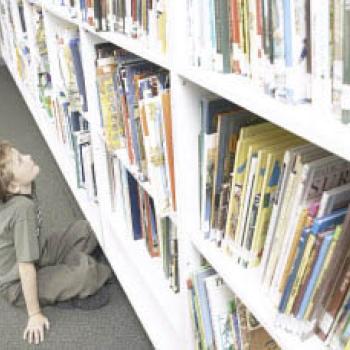Exploring the Library

- Preview |
- Get Started |
- Comments
Activity Description
Libraries are magical places. Visitors can learn about far-away lands, find out how to do new things, follow the fantastic adventures of fictional and real-life heroes, and even solve mysteries and find the answers to burning questions. With a child, explore the many free programs and resources available in a local or online library to find out ways to keep active all summer long.
Why This Is Helpful
All children must be equipped to meet today's challenges with the skills and abilities to find, use, and determine the quality of information. They can learn many of these skills and processes at the library. Libraries and credentialed school librarians play key roles in promoting information literacy by helping children acquire critical thinking skills and increase their global awareness. When children and their families visit the library together, they can learn many lifelong skills, many of which will be helpful at home, at school, and in their community.
This activity was modified from the ReadWriteThink lesson plan "Dear Librarian: Writing a Persuasive Letter."
What You Need
- Ability to travel to a library OR a computer and Internet access
- Online Book Cover Creator
Here's What To Do
- There are thousands of libraries around the country! Find one located near you, and plan a visit.
- Once you get there, get a library card. Library cards are usually free to people living in the library's district.
- After you have a library card, children and families can begin borrowing materials and resources. Most libraries require an adult signature for children's library cards.
- Ask a librarian to help you find the resources appropriate for the child's ability level. Librarians are great resources. They can answer questions and help you find books, videos, and other resources. They can even give you a tour of the library and show you all that libraries have to offer.
- Once you are familiar with the library, go exploring!
- Find things that you can check out and take home to explore further: books, magazines, journals, computer software, CDs, videos, and DVDs. There are even books on tape!
- There are often computers you can use at the library. Play games, check e-mail, surf the Web! For a small fee, you can print things from the computer, send and receive faxes and make copies.
- In the summer, many libraries offer a variety of special programs. Some ask children to read and record their books throughout the summer. Other libraries hold classes and camps. Check to see if there are also programs throughout the school year.
- Once children find a book to check out and take home, invite them to design a new cover for their book. Use paper and art supplies, or visit the Online Book Cover Creator. See the Book Cover Creator Tool page for how to use the tool and other project ideas.
- If you can't make it to a library this summer, visit one online! The Library of Congress is a great resource:
The Library of Congress (LOC) is the largest library in the world and it is also the country's oldest cultural institution. It houses almost 128 million items; including books and other printed materials, recordings, photographs, maps, and manuscripts. The LOC's mission is to make its wealth of resources available to the Congress and the American people.
- Introduce children to the resources available at the Library of Congress Web site by conducting one of these searches:
- See what happened this day in history.
- Explore Immigration in America with interviews, information on immigrants from all over the world, a timeline, and more.
- Investigate you home state's history or explore another state that interests you or that you plan to visit.
- Select from presidents, reformers, explorers, musicians, authors, scientists, inventors, and athletes to learn more about Amazing Americans.
- After selecting and reading something from the library, mark it on a Reading Record.
More Ideas To Try
- Have a scavenger hunt in the library. Find section signs, shelf labels, spine labels, and so on. Or, locate certain genres of books-reference books, mysteries, poetry, books about animals, and so forth.
- Invite children to problem solve, focusing on the question, "If there is a book that you really want the library to purchase, what can you do?" Children can write a persuasive letter to a librarian, requesting that a book they are interested in be added to the library collection.
- You can also read Emily's Runaway Imagination by Beverly Cleary, which explores the adventures of a girl who writes a letter to the State Librarian requesting books for their new library.

Add new comment